Storm door closers are essential for keeping your storm door securely closed, preventing insects and other debris from entering your home. However, if the closer is not properly lubricated, it may become noisy and less effective over time. In this guide, we will discuss how to lubricate storm door closer to ensure smooth operation and prolong its lifespan.
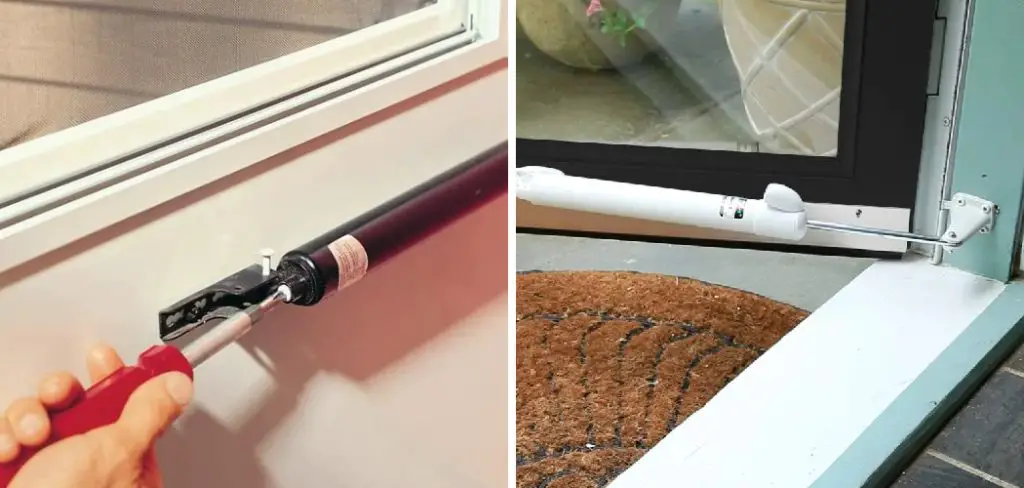
Why Lubrication is Important
Lubricating your storm door closer is important for several reasons. First, it helps to reduce the wear and tear on the closer components, allowing it to operate smoothly without excessive friction. This can prevent premature damage and extend the life of your door closer.
Additionally, regular lubrication can help keep your storm door operating quietly. Without proper lubrication, the closer may become noisy and make squeaking or creaking sounds when opening and closing. This can be not only annoying but also a sign that your door closer needs attention.
Necessary Items
Before you begin lubricating your storm door closer, make sure you have the following items on hand:
- Lubricant: Choose a silicone-based spray or liquid lubricant specifically designed for use on door closers.
- Screwdriver: Depending on the type of storm door closer you have, you may need to use a screwdriver to remove any covers or panels before accessing the closer mechanism.
- Rag or Cloth: This will be used to clean any excess lubricant and wipe it down closer after lubrication.
12 Steps on How to Lubricate Storm Door Closer
Step 1: Identify the Type of Closer
The first step is to identify the type of storm door closer you have. There are three common types: regular, top-jamb, and parallel arm closers. Depending on the type, the lubrication process may vary slightly.
Step 2: Prepare your Workspace
Make sure you have enough space to work around your storm door without any obstructions. Lay down a drop cloth or old newspaper to catch any excess lubricant that may drip.

Step 3: Remove Any Covers or Panels
If your storm door closer has any covers or panels, use a screwdriver to remove them and expose the closer mechanism. If you have a regular closer, you may need to remove the pin that connects the closer arm to the bracket.
Step 4: Clean the Closer
Using a rag or cloth, wipe down the closer to remove any dirt, debris, or old lubricant. This will ensure that the new lubricant can penetrate and properly coat all moving parts. When cleaning, make sure to also check for any signs of damage or wear and tear on the closer.
Step 5: Apply Lubricant
Shake your chosen lubricant well before using it. Then, spray or apply a small amount of lubricant onto the pivot points and moving parts of the closer mechanism. Be careful not to overspray, as this can lead to excess lubricant build-up.
Step 6: Operate the Door
Open and close the door a few times to allow the lubricant to distribute evenly across all moving parts. This will also help to loosen up any stiff or stuck components. So, make sure to open and close the door a few times before proceeding to the next step.
Step 7: Check for Excess Lubricant
After operating the door, check for any excess lubricant that may have dripped or accumulated. Use your rag or cloth to wipe away any excess lubricant from the closer and surrounding area. While some lubricant residue is expected, too much can attract dirt and debris, causing more harm than good.
Step 8: Lubricate the Piston
If you have a top-jamb or parallel arm closer, make sure to also lubricate the piston rod. This is the part that extends from the closer body and attaches to the door frame. Apply lubricant to the rod and pivot points, then open and close the door a few times to distribute it evenly.
Step 9: Check for Proper Tension
As you operate the door, pay attention to how easily it opens and closes. If there is too much tension or resistance, this may be a sign that your closer needs adjustment or replacement. Make note of any issues and address them as needed.
Step 10: Reattach any Covers or Panels
After you are satisfied with the lubrication, reattach any covers or panels that were removed in step 3. Make sure they are secured properly to avoid any accidents or damage. Evenly tighten any screws or bolts to ensure the closer is securely in place.
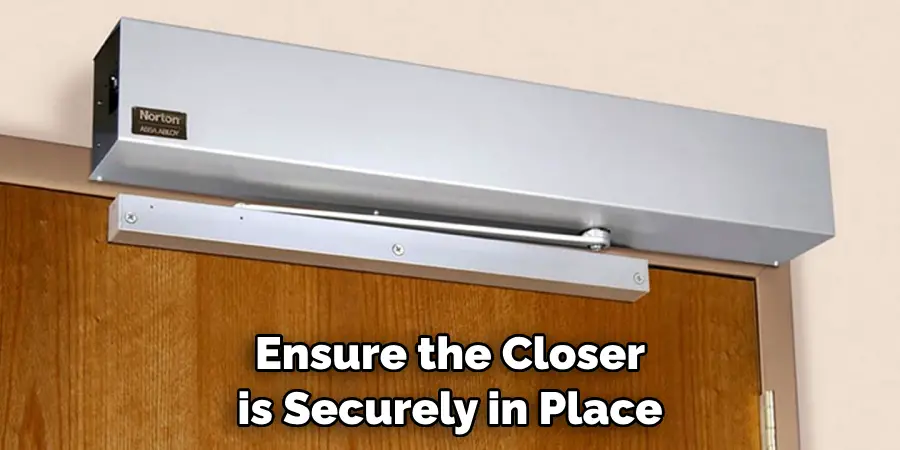
Step 11: Test the Door
Operate the door again to make sure it is opening and closing smoothly and quietly. If you notice any issues, recheck the tension and lubrication or consider replacing the closer if necessary. Can also check for any signs of damage or wear and tear on the closer.
Step 12: Repeat Every Few Months
Regular lubrication is essential for keeping your storm door closer in good working condition. Therefore, it is recommended to repeat this process every few months or as needed to ensure optimal performance.
Lubricating your storm door closer may seem like a small task, but it can make a significant difference in the functionality and lifespan of your door closer. By following these steps on how to lubricate storm door closer and regularly maintaining your storm door, you can ensure smooth operation and prevent any potential issues from arising.
Remember to always use the proper lubricant, operate the door before and after lubrication, and check for any signs of damage or wear and tear. With proper care, your storm door closer can continue to serve its purpose for years to come.
9 Safety Measures to Keep in Mind
1) Use a Silicone-Based Lubricant
To avoid any damage to your storm door closer, make sure to use a silicone-based lubricant specifically designed for this purpose. Some lubricants may contain harsh chemicals that can cause corrosion or damage to the closer mechanism.
2) Wear Protective Gear
When working with any lubricant, it is essential to protect your skin and clothing. Wear gloves and protective eyewear to avoid any contact with the lubricant or potential splatters. Also, avoid wearing loose clothing that can get caught in the closer mechanism.
3) Keep Children and Pets Away
It is best to keep children and pets away from your workspace while lubricating your storm door closer. The door may suddenly close or open during the process, which can be dangerous for little ones or animals.
4) Follow Proper Handling Instructions
Make sure to read and follow any handling instructions provided by the lubricant manufacturer. Some lubricants may require shaking or specific storage conditions, so it is essential to handle them correctly.
5) Use a Ladder if Needed
If your storm door closer is located higher up on your door or you have difficulty reaching it, use a ladder to safely access and work on the closer. Make sure the ladder is sturdy and placed on a flat surface before climbing.
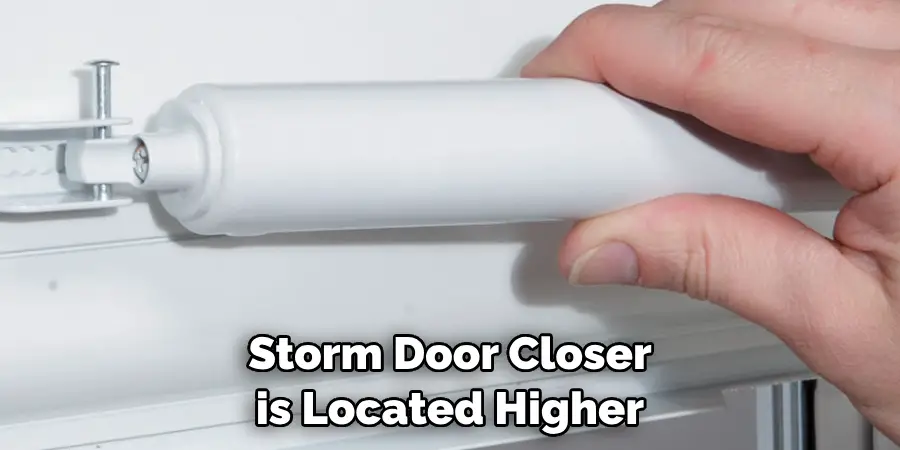
6) Turn Off Power Tools
If you are using power tools to remove covers or panels, make sure to turn them off and unplug them before proceeding with the lubrication process. This will prevent any accidents or injuries from occurring.
7) Dispose of Excess Lubricant Properly
Always dispose of excess lubricant and any rags or cloths used in the process properly. Do not leave them lying around, as they can be a hazard to children, pets, and the environment. Also, avoid pouring lubricant down drains or toilets, as it can clog pipes.
8) Avoid Over-Lubricating
Using too much lubricant can do more harm than good. It can attract dust and debris, causing the closer mechanism to become stuck or malfunction. Use a small amount of lubricant and wipe away any excess to ensure smooth operation.
9) Seek Professional Help if Needed
If you encounter any issues or are unsure about how to properly maintain your storm door closer, it is always best to seek professional help. A qualified technician can inspect and service your closer as needed, ensuring safe and efficient functioning. Never attempt to repair or replace a closer yourself unless you have the proper knowledge and training.
Your safety and the proper functioning of your storm door should always be the top priority. Overall, by following these steps and keeping these safety measures in mind, you can keep your storm door closer in good condition and enjoy a smoothly operating door for years to come.
8 Things to Avoid When Lubricating Your Storm Door Closer
1) Using the Wrong Type of Lubricant
Using a lubricant that is not specifically designed for storm door closers may cause damage and potentially void any warranties. Make sure to use a silicone-based lubricant recommended by the closer manufacturer.
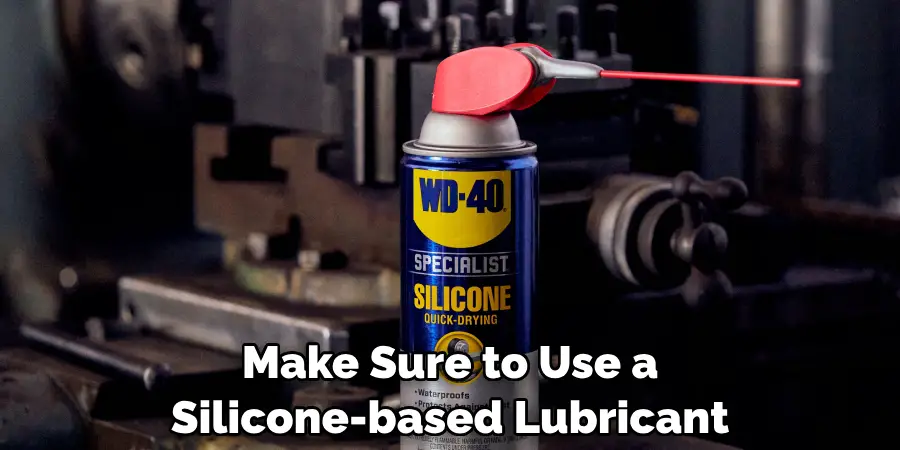
2) Ignoring Signs of Damage or Wear
Before lubricating, inspect your storm door closer for any signs of damage or wear. If you notice any significant issues, it may be best to replace the closer instead of trying to lubricate it. While lubrication can improve functionality, it cannot fix a broken or worn-out closer.
3) Incorrectly Adjusting Tension
Adjusting the tension on your storm door closer is essential for proper operation. However, make sure to follow the manufacturer’s recommendations and not over-tighten or loosen the tension. This can cause issues with the closer’s performance and potentially damage the door or frame.
4) Not Performing a Test Run
Before lubricating, it is crucial to test the door’s opening and closing to get a baseline for its performance. After lubricating, do another test run to see if there are any improvements or issues that need to be addressed.
5) Using Excessive Force
When operating your storm door, avoid using excessive force to open or close it. This can put unnecessary strain on the closer and cause damage over time. More force does not necessarily mean a smoother closing door.
6) Skipping Regular Maintenance
Regular lubrication is just one aspect of maintaining your storm door closer. Neglecting other necessary maintenance tasks, such as tightening screws and inspecting for damage or wear, can lead to more significant issues down the road.
7) Using Tools Improperly
If you need to use tools for any part of the lubrication process, make sure to use them correctly. Misusing or mishandling tools can cause accidents and injuries. If you are unsure about how to use a tool or feel uncomfortable, it is best to seek professional help.
8) Rushing Through the Process
Lubricating your storm door closer should not be rushed. Take your time and follow all proper steps and safety measures. This will ensure that the job is done correctly and safely, leading to better results in the long run.
By avoiding these common mistakes, you can effectively maintain your storm door closer and enjoy a smoothly operating door for years to come. Remember to always prioritize safety and follow proper guidelines and instructions when working on any home maintenance tasks.
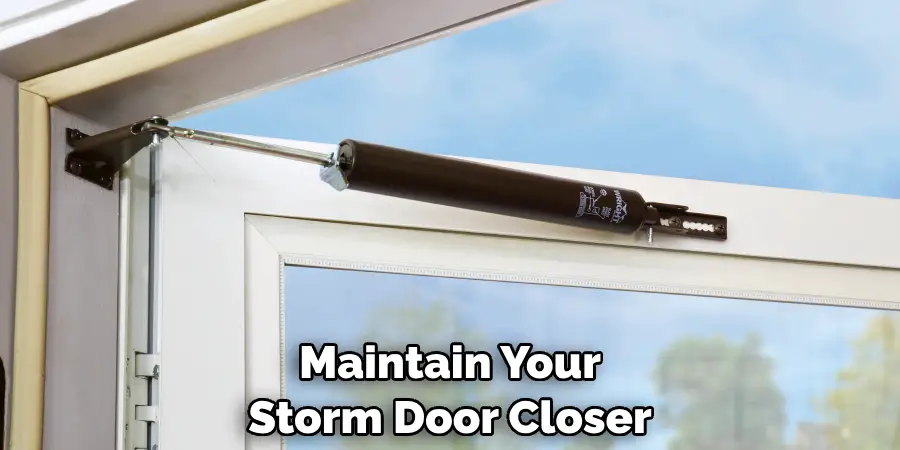
Overall, by following these steps on how to lubricate storm door closer and keeping these safety measures in mind, you can keep your storm door closer in good condition and enjoy a smoothly operating door for years to come. Remember to always prioritize safety and follow proper guidelines and instructions when working on any home maintenance tasks.
8 Additional Tips for Maintaining Your Storm Door Closer
1) Clean and Inspect Regularly
In addition to lubrication, it is essential to clean your storm door closer regularly. This will remove any built-up dirt or debris that can affect its performance. While cleaning, also inspect the closer for any signs of damage or wear.
2) Check Screws and Hardware
Loose screws and hardware can cause the storm door closer to malfunction. Regularly check and tighten any loose screws or bolts to keep the closer in good working condition. Also, make sure to use the correct size and type of hardware recommended by the manufacturer.
3) Keep Closer Protected from Extreme Weather
Exposure to extreme weather conditions such as high winds, heavy rain, or direct sunlight can cause damage to your storm door. Consider installing a wind chain or using a protective cover during severe weather to prevent any potential damage.
4) Replace When Necessary
Like any other mechanical device, a storm door closer will eventually need to be replaced. If you notice significant issues or constant malfunctions, it may be time for a replacement. It is always best to consult with a professional before attempting to replace the closer yourself.
5) Be Mindful of Children and Pets
When working on maintaining or repairing your storm door closer, be mindful of children and pets in the area. Ensure they are at a safe distance and cannot accidentally get caught in the door or any moving parts.
6) Lubricate Moving Parts
Aside from lubricating the closer arm, it is also essential to lubricate any other moving parts, such as hinges and rollers on the storm door. This will help the door operate smoothly and prevent any undue strain on the closer.
7) Don’t Ignore Unusual Noises or Movement
If you hear unusual noises or notice strange movements from your storm door, it may be a sign that something is wrong with the closer. Do not ignore these signs and address them promptly to avoid further damage.
8) Consult a Professional
If you are unsure about how to maintain or repair your storm door closer, it is always best to consult a professional. They can provide expert advice and ensure the job is done correctly and safely. Additionally, if you encounter any significant issues with your closer, it may be best to seek professional help instead of attempting to fix it yourself.
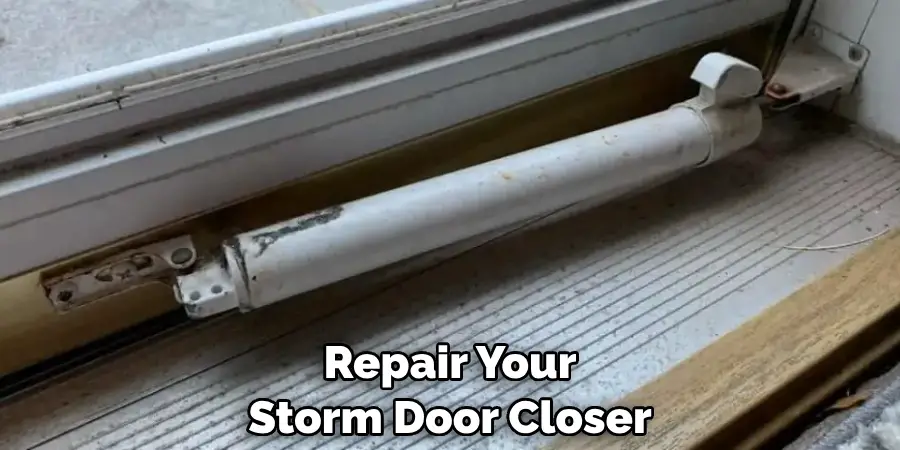
By following these additional tips on how to lubricate storm door closer, you can effectively maintain your storm door closer and prolong its lifespan. Remember to regularly inspect, clean, and lubricate the closer for optimal performance. If you encounter any significant issues or are unsure about how to proceed with maintenance or repairs, don’t hesitate to seek professional help.
Keeping your storm door closer and in good condition will not only ensure a smoothly operating door but also enhance the safety and security of your home. So, take the time to properly maintain your storm door closer and enjoy all the benefits it has to offer.
Frequently Asked Questions
How Often Should I Lubricate My Storm Door Closer?
It is recommended to lubricate your storm door closer every 6-12 months, depending on usage and environmental conditions. However, it is best to test the door’s performance before and after lubrication to determine if additional maintenance is needed.
Can I Use Any Type of Lubricant?
No, it is essential to use a lubricant specifically designed for door hinges and closers. Avoid using oil-based products or silicone sprays as they can attract dirt and debris and cause the closer to malfunction.
Is It Safe to Repair My Own Storm Door Closer?
If you have experience with home maintenance tasks and feel confident in your abilities, you can attempt to repair your storm door closer. However, if you are unsure or uncomfortable with the process, it is best to seek professional help to avoid any accidents or injuries.
Remember to always prioritize safety and follow proper guidelines and instructions when working on home maintenance tasks. Overall, by regularly maintaining and caring for your storm door closer, you can ensure its longevity and enjoy a smoothly operating door for years to come.
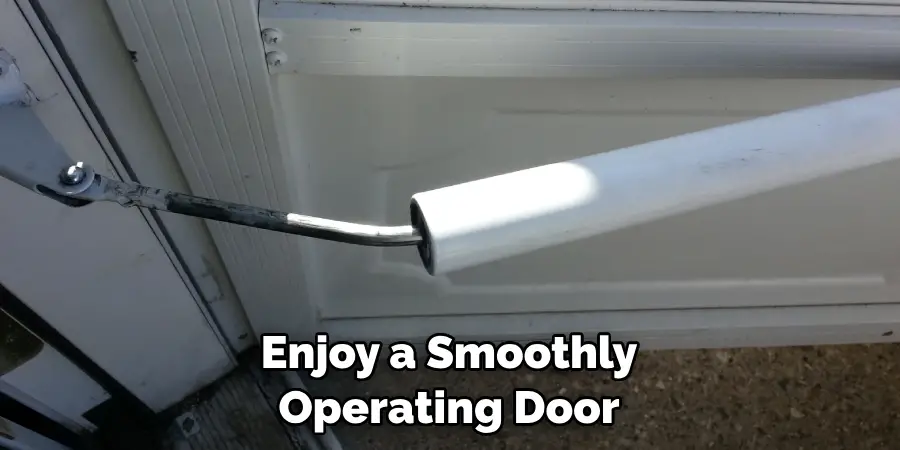
Conclusion
Maintaining your storm door closer may seem daunting, but it is essential to ensure the proper functioning of your storm door. By following the tips outlined on how to lubricate storm door closer, you can easily maintain your closer and avoid common mistakes that can lead to malfunctions and damage.
Remember to regularly inspect, clean, and lubricate your closer and address any issues promptly to prolong its lifespan. And when in doubt, always consult a professional for help. Your safety and the proper functioning of your door should always be a top priority. So, take the time to properly maintain your storm door closer and enjoy all its benefits for years to come.
